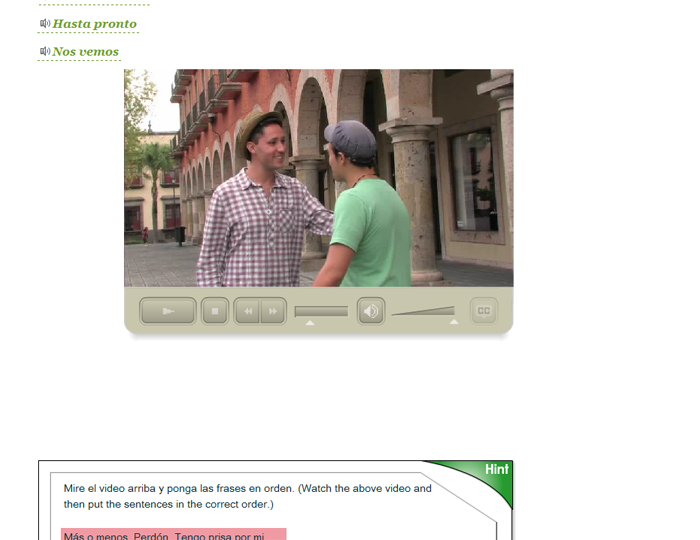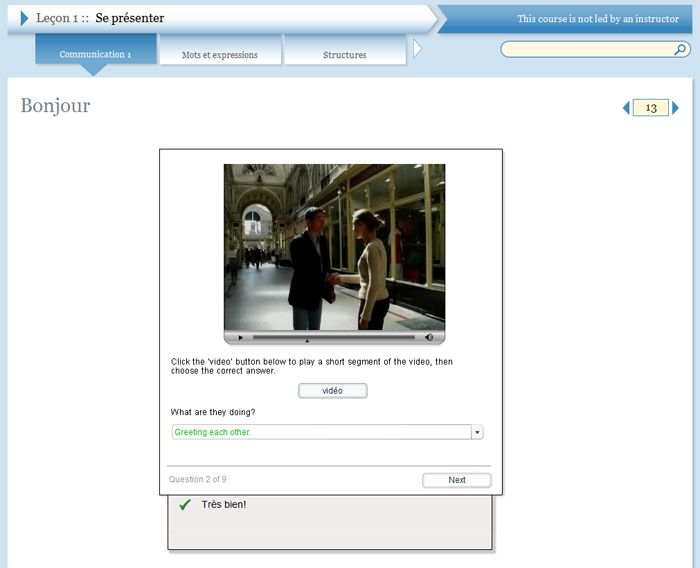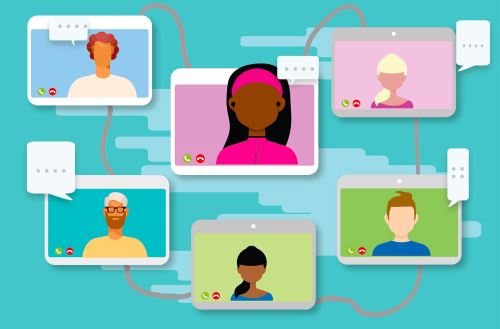Learn Spanish 2 at your own pace in a media-rich and interactive environment, driven by video that was shot on-site in Guadalajara, Mexico.
Spanish 2 — Independent Learners
$10
- Description
- What students will learn
- Learning objectives by module
- Other course details
- System requirements
Description
Spanish 2 is media-rich and interactive, driven by video that was shot on-site in Guadalajara, Mexico. This course is available for low-cost use by independent learners. Please note: the Open & Free version of Spanish 2 contains just a sample of the content, and not the full course.
To successfully use this course, you should be a motivated student with a sincere desire to learn the Spanish language and about cultures in the Spanish-speaking world, and be comfortable with computer technologies. This course is self-paced, and each module will involve around 8 hours of work.
Once you have decided that this course is appropriate for you, it will be helpful to know how the course functions. Each lesson is organized around a theme and divided into six sections. The sections are:
1. Funciones comunicativas: In this first section, you will be introduced to the practical function that the lesson serves in the real world – what it will enable you to do and why it is important. You will gain insight into how speakers of Spanish use certain types of language, for example how to make commands or give recommendations. In addition, through the presentation of short dialogues and video, this section contains much of the active vocabulary you will need for the lesson as a whole, so pay close attention! It is important to understand that you may not understand each and every word; don’t be frustrated, that is part of the learning process — to understand as much as possible from context without knowing each and every word.
2. Vocabulario: In this section you will find a very straightforward presentation of words and expressions that you will need to talk about the lesson’s theme. These lists most often are words that were not presented already in the “Funciones” section. You can click on each word to hear pronunciation and also see rollover translations.
3. Estructuras gramaticales: Here you will find the ‘nuts and bolts’ of the lesson, in other words, more detailed explanations of grammar rules and how the language works. So, you will learn such things as verb conjugations, or what word order to use in certain types of sentences, for example. This section will give you more insight into patterns of the language so that you can move from simple words to longer, more complex expression, both in writing and in conversation. Since you will be working independently in most cases, we have provided rather detailed explanations of how the language works.
4. Esbozos culturales: In Esbozos culturales, you will be reading short selections on a wide variety of cultural topics — famous figures from the world of art, music, film, and literature. In Esbozos culturales, you also will find readings about different Spanish speaking countries; these will provide you with a brief background of the countries, and give you some insight into just how diverse the Spanish speaking world is. In this section, you will also be exposed to grammar and vocabulary that you will strive to understand from context as there will be words, phrases and structures that you will not yet have mastered. In some cases, translations are provided, in others, you will be working from the context to understand the passage.
5. Actividades : This section has important assignments that give you the opportunity to synthesize the entire lesson and to practice all that you have learned. Here, you will find three different types of assignments: writing practice, oral practice and chat room practice. The writing practice are short paragraphs based on the lesson’s theme or messages; on occasion you will share your writing in a discussion board forum; in oral practice, you are given prompts to do one-on-one conversations with your professor or a native-speaker assistant – to practice what you have learned in a natural, conversational contexts; in this section you will also find assignments to make voice recordings so that you can gain extra oral practice and receive feedback on your pronunciation. Chat room assignments ask you to practice a little more to use the language creatively!
6. Evaluación : In this section you will find a lesson test, based on the vocabulary, grammar and cultural topics. These tests are quite similar in structure and content to the exercises and assignments that are in each lesson.
7. Material complementario : This section is optional. While some of the extra vocabulary words may appear on occasion in exercises, the materials here will not be included in tests (unless your own instructor specifies otherwise). There are extra vocabulary lists to add on to what you have already learned, web resources that provide links to videos and texts that supplement the lesson. This section is meant to give you some additional resources but is not mandatory.
This course is part of a two-semester sequence (Spanish I & II). Each course is divided into twelve thematic lessons, with ample opportunity for reentry and review. Completing both courses will require two semesters. Each lesson contains short video components to contextualize the material. Segments of the video are then replayed in a variety of interactive activities and tutors. All videos were filmed in Mexico or Cuba, incorporating authentic speech, cultural references, and gestures.
The beginning of each lesson is always a set sequence, from recognition of language, through explicit learning of grammar and pronunciation, to written and spoken production. After this ordered beginning, many activities are offered to the student in which the language learned is used in understanding new texts, sounds or videos, or in creative production. Lesson tests and exams are available to students enrolled in instructor-led courses. The Learning Dashboard allows for at-a-glance evaluation of student progress based on each lesson’s learning objectives.
What students will learn
By the end of this course, students will learn to:
- Identify the main ideas in a conversation and a written text
- Use written and oral phrases to talk about the past, present, and future
- Make cultural comparisons through writing and speaking about health, vacation, and political opinions
- Give and receive advice about a variety of topics
Learning objectives by module
Lesson 1:
By the end of this lesson, you will be able to:
- talk about your eating habits
- discuss menus
- shop for food
- talk about food preparation
- order food in a restaurant
Lesson 2
By the end of this lesson, you will be able to
- Talk about what you used to do
- Describe how life used to be
- Discuss states and conditions that existed during your childhood
Lesson 3
By the end of this lesson, you will be able to
- Describe extended family members and relationships
- Discuss what you do with your family
- Ask questions about the past
Lesson 4
By the end of this lesson, you will be able to
- Narrate past experiences
- Talk about places where you have traveled
- Make plans and reservations for travel
- Compare accommodations in the Spanish-speaking world
Lesson 5
By the end of this lesson, you will be able to:
- Discuss how the environment and travel interact
- Ask people to do things
- Explain the differences between tourism in Costa Rica and in your own country
Lesson 6
By the end of this lesson, you will be able to
- Express needs, desires, and emotions related to health
- Discuss the differences between health care in Latin America and in your own country
- Use vocabulary for body parts to describe your health and routines
Lesson 7
By the end of this lesson, you will be able to
- Express your opinions and beliefs about health
- Talk about unplanned occurrences and accidents
- Compare the linguistic situation of Paraguay to your context
Lesson 8
- Explain the importance of art in different Spanish-speaking countries
- Express doubts through writing and speaking
- Talk and write about theater, music, painting, and the arts
Lesson 9
By the end of this lesson, you will be able to
- Speculate about future events
- Discuss causes and effects of environmental change
- Compare the way the environment is treated in different Spanish-speaking countries
Lesson 10
By the end of this lesson, you will be able to
- Talk about technology and its impact on our lives
- Discuss the press and media and their role in shaping our opinions
- Write about what you would do in hypothetical situations
Lesson 11
By the end of this lesson, you will be able to
- Discuss politics with those who have different opinions
- Talk about what you would have done differently in the past
- Recognize differences in Spanish-speaking political systems
Lesson 12
By the end of this lesson, you will be able to
- Apply to a job in Spanish
- Use workplace vocabulary
- Communicate across workplace situations through written and audiovisual situations
Other course details
System requirements
OLI system requirements, regardless of course:
- internet access
- an operating system that supports the latest browser update
- the latest browser update (Chrome recommended; Firefox, Safari supported; Edge and Internet Explorer are supported but not recommended)
- pop-ups enabled
- cookies enabled
Some courses include exercises with exceptions to these requirements, such as technology that cannot be used on mobile devices.
This course’s system requirements:
- for academic course key students only: chat environment and audio recording.






